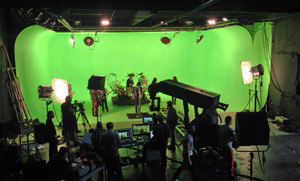The Culver City studio that was home to the production of classics such as “Gone With the Wind” and “The Wizard of Oz” could soon be home to a new generation of stars, such as online video-gamer Felix Kjellberg (PewDiePie), creator of YouTube’s most watched channel, or Vine sensation-turned-actor Cameron Dallas.
The owner of 100-year-old Culver Studios submitted entitlement applications earlier this month seeking approval of a renovation project that includes plans to attract more online shoots to the studio through a number of upgrades aimed squarely at digital video producers.
Hackman Capital Partners, a Westwood investment firm that owns the storied studio site, is investing millions of dollars in the effort. The application reflects how the traditional entertainment industry is moving toward digital-first producers.
Culver Studios was home to digital media firm Fullscreen Inc. until it decamped for Playa Vista earlier this year, yet attracting producers of online content hadn’t been a priority. But it is now, said Michael Goldfarb, director of business development and strategic planning at the studio.
Even though its 13 soundstages are occupied, the studio decided it wants to grow its customer base beyond traditional film and TV companies. It plans to include specific amenities and build-outs that cater to online video creators, as well as the networks they work with. Such amenities will include improvements to the studio’s electrical and broadband infrastructure and more office and digital production space.
“That’s what we’re figuring out right now by doing research and meeting with these companies to see what they’re looking for,” said Goldfarb, who noted that a construction timetable hasn’t been approved yet. A decision on the studio’s application is expected before the end of the year.
“We want to stay relevant for the next 100 years,” he said.
Vertical integration
A few miles south of Culver City, Thunder Studios, a 150,000-square-foot production facility in Long Beach, has also spent money to lure online shoots.
It has upgraded its facilities to include better camera and postproduction equipment, improved physical sets and added other production gear. Separate stages specifically designed to shoot e-sports competitions and virtual reality content are in the works as well, and catering services and a new Starbucks are now on the site.
Thunder officials, who plan to operate the studio as a 24-hour facility before the end of the year, also declined to disclose how much was spent on renovations.
Rather than renting out its space to digital productions as Culver Studios plans to do, Thunder is offering up its facility for free in exchange for a cut of advertising revenue generated by content produced on site. The studio also said it could fund production costs of select online projects.
In January, it acquired YouTube multichannel network Power Up TV for an undisclosed sum as another way to lure online video creators to its facility. As a bonus for joining its Thunder TV network, which launched July 27 and includes Power Up channels, creators accepted into the network can use Thunder’s facilities for free for as many days as they like, depending on availability. Like all multichannel networks, creators negotiate an advertising revenue split with the company. If the YouTubers aren’t happy with the arrangement, they can walk away at any time, according to Thunder.
So far, 65 creators have used its facilities during the last two months, and 200 have joined Thunder TV, according to the company. Production and business workshops focused on creating Internet content will also be available to members of its network in coming months.
“We want to open this up to creators that have some traction and help them become more popular,” said Stephan Manpearl, Thunder’s chief marketing officer. “That’s where the industry is going.”
All of that might be appealing to content creators not eligible to shoot at Google Inc.’s YouTube Space LA in Playa Vista. Built in 2012, the high-tech, 41,000-square-foot facility offers free access to YouTubers that increases based on the number of subscribers they have.
But not all independent production studios see the value in trying to attract more YouTubers. Take Hollywood’s Raleigh Studios, which hasn’t seen a lot of demand from Internet content creators, said Christopher Cope, vice president of sales and marketing.
Traditional focus doubts
While it’s not opposed to renting out space to online video shoots should they inquire, Cope said Raleigh is busy enough with long-term film and television productions and is not planning any upgrades to cater specifically to the digital market.
“The effort it would take in order to facilitate that kind of business is not worth the revenue we would gain from it,” said Cope.
That could be because digital productions don’t require much time to shoot, and even though budgets are increasing, they’re still a fraction of the millions of dollars that Hollywood studios, as well as streaming services such as Netflix and Amazon.com Inc., spend to create content.
A smaller 6,700-square-foot stage at Raleigh that is usually rented out to shoot commercials costs about $2,500 for a day.
“It may not make economic sense today, but that’s where the world is going as part of the overall platform for distribution of content,” said Peter Csathy, chief executive of West L.A. consultancy Manatt Digital Media.
He added that physical production houses would be wise to start making inroads with the growing number of companies funding digital shoots.
“You’ve got to be where the millennials are if you’re in the production business,” he said.

